-
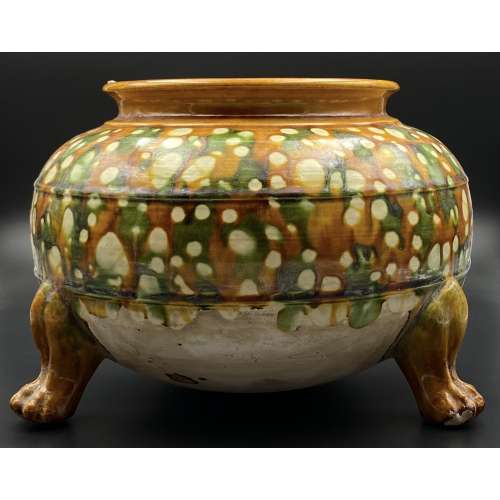 A tripod earthenware jar with the upper half decorated with three-colour glaze in brown, green, and white, and the bottom half unglazed; spur marks to the mouth. Henan kiln. China, the Tang dynasty [唐朝] (618 – 907). Diameter: 22 cm; Height: 15.5 cm
A tripod earthenware jar with the upper half decorated with three-colour glaze in brown, green, and white, and the bottom half unglazed; spur marks to the mouth. Henan kiln. China, the Tang dynasty [唐朝] (618 – 907). Diameter: 22 cm; Height: 15.5 cm -
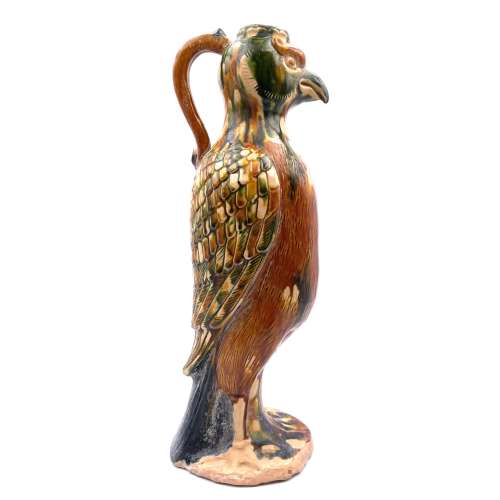 Made of two moulded symmetrical halves, joined before attaching the handle. On an unglazed base. Glazed in three colours (green, amber and ivory) and the tail is glazed black or dark blue. China, the Tang dynasty [唐朝] (618 – 907). Height: 37 cm.
Made of two moulded symmetrical halves, joined before attaching the handle. On an unglazed base. Glazed in three colours (green, amber and ivory) and the tail is glazed black or dark blue. China, the Tang dynasty [唐朝] (618 – 907). Height: 37 cm. -
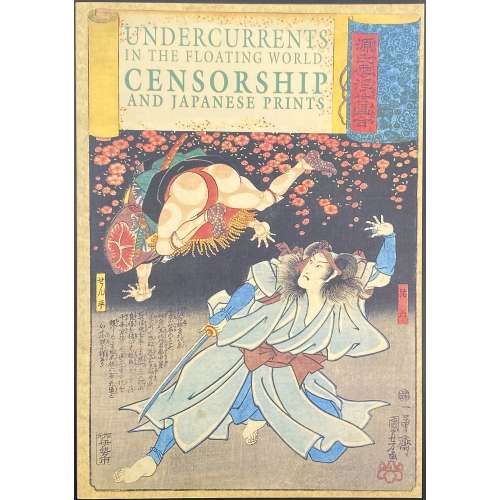 Paperback, 27.5 x 19 cm, pictorial wrappers, lettering to front wrapper and spine, pp.: [i-iv] v-viii, 1-104, ils.: 50 figures; catalogue, notes, and bibliography. Title-page: UNDERCURRENTS | IN THE FLOATING WORLD: | CENSORSHIP | AND JAPANESE PRINTS | Sarah E. Thompson | H. D. Harootunian | {kiwame seal} | THE ASIA SOCIETY GALLERIES | NEW YORK || Exhibition in NY: October 9, 1991 – January 5, 1992. Authors: Sarah E. Thompson (American, b. 1951) Harry D. Harootunian (Armenian-American, b. 1929)
Paperback, 27.5 x 19 cm, pictorial wrappers, lettering to front wrapper and spine, pp.: [i-iv] v-viii, 1-104, ils.: 50 figures; catalogue, notes, and bibliography. Title-page: UNDERCURRENTS | IN THE FLOATING WORLD: | CENSORSHIP | AND JAPANESE PRINTS | Sarah E. Thompson | H. D. Harootunian | {kiwame seal} | THE ASIA SOCIETY GALLERIES | NEW YORK || Exhibition in NY: October 9, 1991 – January 5, 1992. Authors: Sarah E. Thompson (American, b. 1951) Harry D. Harootunian (Armenian-American, b. 1929) -
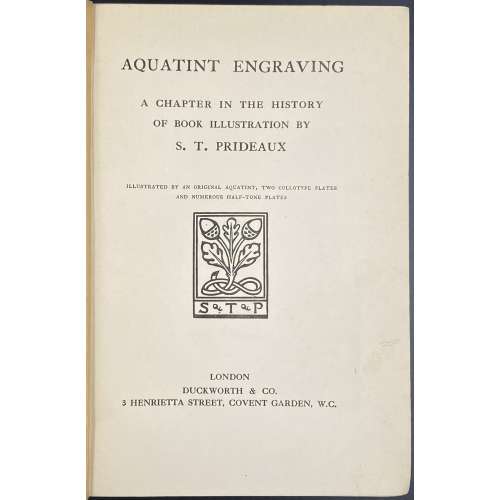 Half-title: AQUATINT ENGRAVING || Title: AQUATINT ENGRAVING | A CHAPTER IN THE HISTORY | OF BOOK ILLUSTRATION BY | S. T. PRIDEAUX | ILLUSTRATED BY AN ORIGINAL AQUATINT, TWO COLLOTYPE PLATES | AND NUMEROUS HALF-TONE PLATES | [Prideaux device] | LONDON | DUCKWORTH & CO. | 3 HENRIETTA STREET, COVENT GARDEN, W.C. || Pagination: ffl, [i, ii] – h.t. / blank, [2] – blank / frontis. w/guard, [iii, iv] – t.p. / coloph. "First Published, December 1909", [v, vi] – dedication "TO MY FATHER" / blank, vii-xv [xvi], [1] 2-434, bfl, + 24 pl. (incl. port). Collation: [a]6 b8 A-Z8 2A-2C8 2D4 Binding: Original navy cloth, gilt-ruled and lettered front board, gilt lettering to spine, a blind device to back board; upper margin gilt, free margin untrimmed. Author: Sarah Prideaux. "Engravers and the books they illustrated": p. 388-405. "Publications by Ackermann with aquatint plates": p. 374-378. "Biographical notices of engravers whose names appear on the plates": p. 358-371. "Books published before 1830 with aquatint plates": p. 325-357.
Half-title: AQUATINT ENGRAVING || Title: AQUATINT ENGRAVING | A CHAPTER IN THE HISTORY | OF BOOK ILLUSTRATION BY | S. T. PRIDEAUX | ILLUSTRATED BY AN ORIGINAL AQUATINT, TWO COLLOTYPE PLATES | AND NUMEROUS HALF-TONE PLATES | [Prideaux device] | LONDON | DUCKWORTH & CO. | 3 HENRIETTA STREET, COVENT GARDEN, W.C. || Pagination: ffl, [i, ii] – h.t. / blank, [2] – blank / frontis. w/guard, [iii, iv] – t.p. / coloph. "First Published, December 1909", [v, vi] – dedication "TO MY FATHER" / blank, vii-xv [xvi], [1] 2-434, bfl, + 24 pl. (incl. port). Collation: [a]6 b8 A-Z8 2A-2C8 2D4 Binding: Original navy cloth, gilt-ruled and lettered front board, gilt lettering to spine, a blind device to back board; upper margin gilt, free margin untrimmed. Author: Sarah Prideaux. "Engravers and the books they illustrated": p. 388-405. "Publications by Ackermann with aquatint plates": p. 374-378. "Biographical notices of engravers whose names appear on the plates": p. 358-371. "Books published before 1830 with aquatint plates": p. 325-357. -
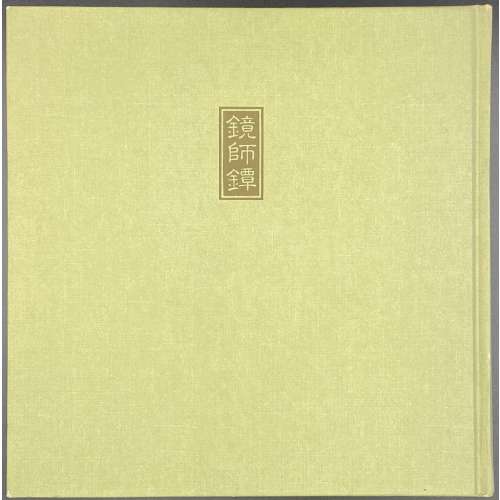 Japanese book: 24 leaves, 22 numbered plates, b/w photography reproduced photomechanically, with descriptions at the facing pages; in Japanese. Hardcover, 19 x 18.5 cm, green cloth stamped with title to front board and spine. Separate translation into English.
Japanese book: 24 leaves, 22 numbered plates, b/w photography reproduced photomechanically, with descriptions at the facing pages; in Japanese. Hardcover, 19 x 18.5 cm, green cloth stamped with title to front board and spine. Separate translation into English. -
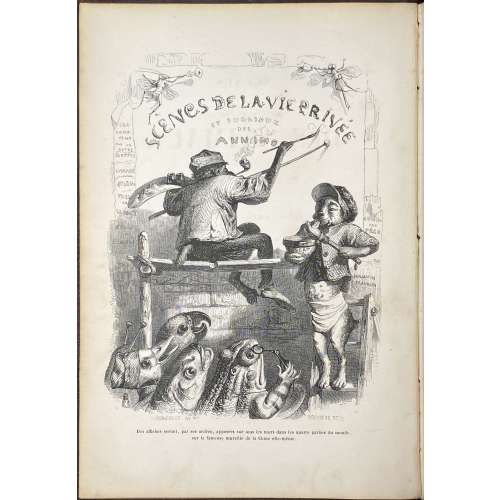 A two-volume set in the contemporary full calf, imitating the editorial cloth binding. Vol. 1: SCÈNES | DE LA | VIE PRIVÉE ET PUBLIQUE | DES ANIMAUX | VIGNETTES | PAR GRANDVILLE. | — | ÉTUDES DE MŒURS CONTEMPORAINES | PUBLIÉES | SOUS LA DIRECTION DE M. P. – J. STAHL , | AVEC LA COLLABORATION | DE MESSIEURS | DE BALZAC. – L. BAUDE. – E. DE LA BEDOLLIERE. – P. BERNARD. – J. JANIN. | ED. LEMOINE. – CHARLES NODIER. – GEORGE SAND. | [VIGNETTE] | PARIS. | J. HETZEL ET PAULIN , ÉDITEURS , | RUE DE SEINE-SAINT-GERMAIN , 33. | 1842 Pagination: [2 blanks] [2 - ht. / imprim.] [2 - blank / frontis.] [2 - t.p. / blank] [4] [1] 2-386 [6 - table] [2 blanks], 96 whole-page wood-engravings after Grandville, vignettes within the text including head and tailpieces, together with a frontispiece. VOL. 2: SCÈNES | DE LA | VIE PRIVÉE ET PUBLIQUE | DES ANIMAUX | VIGNETTES | PAR GRANDVILLE. | — | ÉTUDES DE MŒURS CONTEMPORAINES | PUBLIÉES | SOUS LA DIRECTION DE M. P. – J. STAHL , | AVEC LA COLLABORATION | DE | MM. DE BALZAC, – L' HERITIER (DE L' AIN), – ALFRED DE MUSSET – PAUL DE MUSSET, | CHARLES NODIER, – MADAME M. MENESSIER NODIER, – LOUIS VIARDOT. | [VIGNETTE] | PARIS, | J. HETZEL , ÉDITEUR , | RUE DE SEINE-SAINT-GERMAIN , 33. | 1842 Pagination: [2 - ht. / imprim.] [2 - blank / frontis.] [2 - t.p. / blank] [1] 2-390 [6 - table], 105 whole-page wood-engravings after Grandville, vignettes within the text including head and tailpieces, together with a frontispiece. Size: Each volume 27 x 18 cm; In-4to (usually classified as 8vo, however, the numeric signatures provide for gathering in-quarto). Binding: Full burgundy calf, gilt embossed Grandville's characters to boards and spine, lettering to spine, white moire end-papers to vol. 1, and yellow end-papers to vol. 2, all margins gilt. Combination of the 1st and 2nd print-runs of the 1st edition. Ref.: L. Carteret, 1927: pp. 552-558. Wikipedia; Gallica; Hathi Trust. In: British Museum, MET, RISD Museum, Fine Arts Museums of San Francisco.
A two-volume set in the contemporary full calf, imitating the editorial cloth binding. Vol. 1: SCÈNES | DE LA | VIE PRIVÉE ET PUBLIQUE | DES ANIMAUX | VIGNETTES | PAR GRANDVILLE. | — | ÉTUDES DE MŒURS CONTEMPORAINES | PUBLIÉES | SOUS LA DIRECTION DE M. P. – J. STAHL , | AVEC LA COLLABORATION | DE MESSIEURS | DE BALZAC. – L. BAUDE. – E. DE LA BEDOLLIERE. – P. BERNARD. – J. JANIN. | ED. LEMOINE. – CHARLES NODIER. – GEORGE SAND. | [VIGNETTE] | PARIS. | J. HETZEL ET PAULIN , ÉDITEURS , | RUE DE SEINE-SAINT-GERMAIN , 33. | 1842 Pagination: [2 blanks] [2 - ht. / imprim.] [2 - blank / frontis.] [2 - t.p. / blank] [4] [1] 2-386 [6 - table] [2 blanks], 96 whole-page wood-engravings after Grandville, vignettes within the text including head and tailpieces, together with a frontispiece. VOL. 2: SCÈNES | DE LA | VIE PRIVÉE ET PUBLIQUE | DES ANIMAUX | VIGNETTES | PAR GRANDVILLE. | — | ÉTUDES DE MŒURS CONTEMPORAINES | PUBLIÉES | SOUS LA DIRECTION DE M. P. – J. STAHL , | AVEC LA COLLABORATION | DE | MM. DE BALZAC, – L' HERITIER (DE L' AIN), – ALFRED DE MUSSET – PAUL DE MUSSET, | CHARLES NODIER, – MADAME M. MENESSIER NODIER, – LOUIS VIARDOT. | [VIGNETTE] | PARIS, | J. HETZEL , ÉDITEUR , | RUE DE SEINE-SAINT-GERMAIN , 33. | 1842 Pagination: [2 - ht. / imprim.] [2 - blank / frontis.] [2 - t.p. / blank] [1] 2-390 [6 - table], 105 whole-page wood-engravings after Grandville, vignettes within the text including head and tailpieces, together with a frontispiece. Size: Each volume 27 x 18 cm; In-4to (usually classified as 8vo, however, the numeric signatures provide for gathering in-quarto). Binding: Full burgundy calf, gilt embossed Grandville's characters to boards and spine, lettering to spine, white moire end-papers to vol. 1, and yellow end-papers to vol. 2, all margins gilt. Combination of the 1st and 2nd print-runs of the 1st edition. Ref.: L. Carteret, 1927: pp. 552-558. Wikipedia; Gallica; Hathi Trust. In: British Museum, MET, RISD Museum, Fine Arts Museums of San Francisco. -
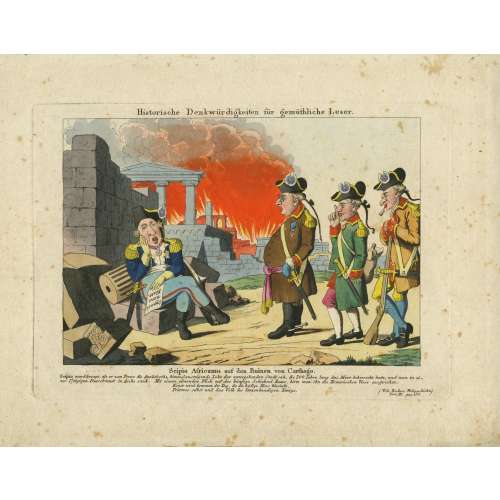 Hand-coloured etching from the series Historische Denkwürdigkeiten für gemütliche Leser by an anonymous German artist, printed c. 1815.
Hand-coloured etching from the series Historische Denkwürdigkeiten für gemütliche Leser by an anonymous German artist, printed c. 1815. -
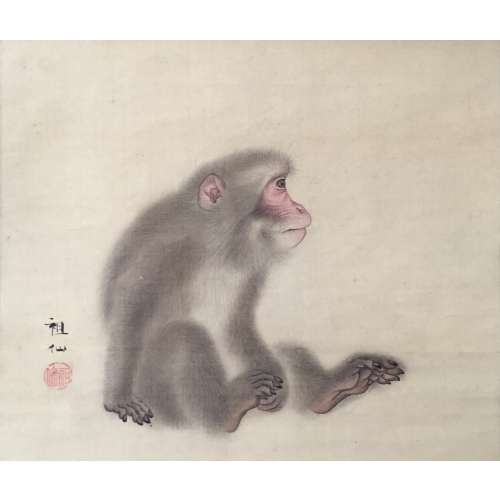 Mori Sosen (1747-1821). Seated Monkey. Hanging scroll painting. Ink and colour on silk. Signed: Sosen. Sealed: Sosen. 28.8 x 33.3 cm.
Mori Sosen (1747-1821). Seated Monkey. Hanging scroll painting. Ink and colour on silk. Signed: Sosen. Sealed: Sosen. 28.8 x 33.3 cm. -
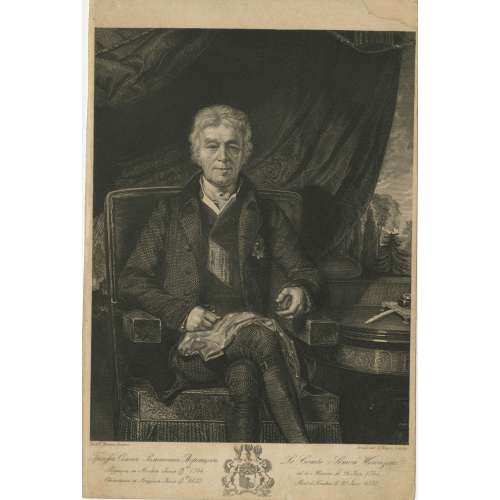
Seated portrait of Russian diplomat Count Semyon Romanovich Vorontsov (Семён Романович Воронцо́в; 26 June 1744 – 9 July 1832). Engraved by August Weger (Born: 1823 in Nürnberg; died: 1892 in Leipzig) from the portrait painted by Richard Evans (1784–1871). Circa 1825-50. Semyon Romanovich Vorontsov, the son of Count Roman Illarionovich and Marfa Ivanovna Surmina, was born on June 15, 1744; Active Privy Councillor; Ambassador to Venice and London from 1784, for over 20 years. Died in London on June 26, 1832.
Inscription: Графъ Семенъ Романовичь Воронцовъ. Родился въ Москвѣ Iюня 15-го/26 1744, Скончался въ Лондонѣ Iюня 9-го/21 1822. | Le Comte Simon Woronzow. né à Moscou le 26 Juin 1744, Mort à Londres le 21 Juin 1832. | Richd. Evans, Peintre. - Gravé par A. Weger, Leipzig. Vorontsov family coat of arms in the middle.
Dimensions: 23 x 15 cm. Ref.: Подробный словарь русских гравированных портретов Д. А. Ровинского, том. 1, 534-540. -
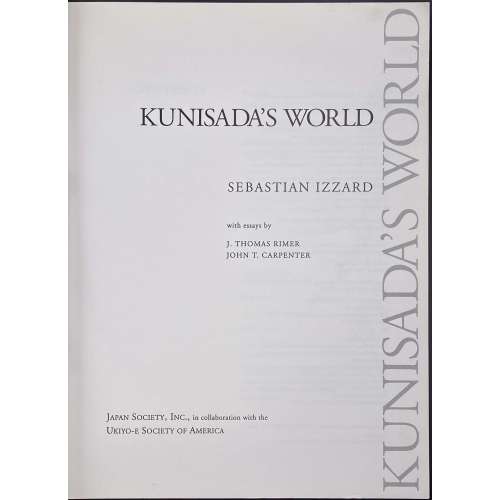 Glossy softcover, publisher’s pictorial wrappers, 30 x 23 cm, pp.: [i-v] vi-xi [xii blank], [2] 3-199 [200 blank], ils.; total 106 leaves. Title-page: Vertical from bottom to top along the outer margin in grey: KUNISADA'S WORLD; horizontally: KUNISADA'S WORLD | SEBASTIAN IZZARD | with essays by | J. THOMAS RIMER | JOHN T. CARPENTER | JAPAN SOCIETY, INC., in collaboration with the | UKIYO-E SOCIETY OF AMERICA || Published in conjunction with an exhibition held at the Japan Society Gallery, New York, September 30 - November 14, 1993. Contents: (1) Kunisada: in and out of his times; Kabuki at the time of Kunisada / J. Thomas Rimer. (2) Popular fiction in the age of Kunisada; Kunisada and the art of comic poetry / John T. Carpenter. (3) Kunisada the artist / Sebastian Izzard. Contributors: Sebastian Izzard J. Thomas Rimer (American, b. 1933) John T. Carpenter (American) Utagawa Kunisada [歌川 国貞] a.k.a. Utagawa Toyokuni III [三代歌川豊国] (Japanese, 1786 – 1865) Select illustrations (references in this collection):
Glossy softcover, publisher’s pictorial wrappers, 30 x 23 cm, pp.: [i-v] vi-xi [xii blank], [2] 3-199 [200 blank], ils.; total 106 leaves. Title-page: Vertical from bottom to top along the outer margin in grey: KUNISADA'S WORLD; horizontally: KUNISADA'S WORLD | SEBASTIAN IZZARD | with essays by | J. THOMAS RIMER | JOHN T. CARPENTER | JAPAN SOCIETY, INC., in collaboration with the | UKIYO-E SOCIETY OF AMERICA || Published in conjunction with an exhibition held at the Japan Society Gallery, New York, September 30 - November 14, 1993. Contents: (1) Kunisada: in and out of his times; Kabuki at the time of Kunisada / J. Thomas Rimer. (2) Popular fiction in the age of Kunisada; Kunisada and the art of comic poetry / John T. Carpenter. (3) Kunisada the artist / Sebastian Izzard. Contributors: Sebastian Izzard J. Thomas Rimer (American, b. 1933) John T. Carpenter (American) Utagawa Kunisada [歌川 国貞] a.k.a. Utagawa Toyokuni III [三代歌川豊国] (Japanese, 1786 – 1865) Select illustrations (references in this collection):
SVJP-0179-3.2014: The Hour of the Tiger, Seventh Hour of Night from the series Twelve Hours of a Modern Clock.

SVJP-0222.2016: A view of the dressing room of a Theater in Dōtonbori, Ōsaka.

SVJP-0105.2014: Ichikawa Danjūrō VIII as the ghost of Seigen.
-
 Hardcover, 30 x 26 cm, publisher's pictorial boards, pp.: [1-5] 6-168, il.
Hardcover, 30 x 26 cm, publisher's pictorial boards, pp.: [1-5] 6-168, il.Published to accompany the recent successful exhibition at the Museu Picasso, Barcelona, this book sheds new light on Picasso's work - his connection with Japanese art. It is illustrated with images
-
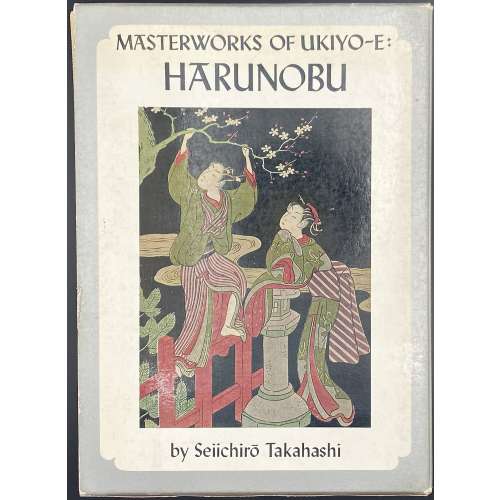 Hardcover volume from the series Masterworks of ukiyo-e, 26.5 x 19.1 cm, bound in unprimed canvas, red characters on black strip to front 春信, red and black lettering to spine, cream embossed endpapers, in a pictorial slipcase with series design (black lettering on silver spine); pp: [1-6]: h.t./frontis. (colour plate pasted in), t.p./imprint, contents/blank), 7-30 text, [2] faux-title, 33-96 (66 colour plates w/captions). Title-page (in frame): MASTERWORKS OF UKIYO-E | HARUNOBU | by Seiichirō Takahashi | English adaptation by John Bester | {publisher’s device} | KODANSHA INTERNATIONAL LTD. | Tokyo, Japan & Palo-Alto, Calif., U.S.A | {vertical, between rules 春信} || Series: Masterworks of ukiyo-e, № 6. Contributors: Seiichirō Takahashi [高橋誠一郎] (Japanese, 1884 – 1982) – author. Suzuki Harunobu [鈴木 春信] (Japanese, 1725 – 1770) – artist. John Bester (British, 1927 – 2010) – adaptation.
Hardcover volume from the series Masterworks of ukiyo-e, 26.5 x 19.1 cm, bound in unprimed canvas, red characters on black strip to front 春信, red and black lettering to spine, cream embossed endpapers, in a pictorial slipcase with series design (black lettering on silver spine); pp: [1-6]: h.t./frontis. (colour plate pasted in), t.p./imprint, contents/blank), 7-30 text, [2] faux-title, 33-96 (66 colour plates w/captions). Title-page (in frame): MASTERWORKS OF UKIYO-E | HARUNOBU | by Seiichirō Takahashi | English adaptation by John Bester | {publisher’s device} | KODANSHA INTERNATIONAL LTD. | Tokyo, Japan & Palo-Alto, Calif., U.S.A | {vertical, between rules 春信} || Series: Masterworks of ukiyo-e, № 6. Contributors: Seiichirō Takahashi [高橋誠一郎] (Japanese, 1884 – 1982) – author. Suzuki Harunobu [鈴木 春信] (Japanese, 1725 – 1770) – artist. John Bester (British, 1927 – 2010) – adaptation. -
![[Charles Octave Moget, Joseph Décembre]. Sempronius. Histoire de la Commune de Paris en 1871. Paris, Décembre-Alonnier, [1871]. – pp: [i, ii - ht, imprim.] iii, iv - t.p., blank] [v - table] vi-viii (viii numbered iii), [1] 2 [3] 4-267 [268 blank] [1] 2-12 advert. [Pseudonym of Charles Octave Moget and Joseph Décembre]. Charles Octave Moget, dit Octave Féré (1815-1875); Joseph Décembre, dit Décembre-Allonier (1836 – 1906).](https://varshavskycollection.com/wp-content/uploads/2021/02/LIB-2445.2020-a-1-500x500.jpeg) Front publisher’s yellow wrapper, in a double frame: SEMPRONIUS | HISTOIRE | DE LA | COMMUNE DE PARIS | EN 1871 | La période impériale. – La Révolution du 4 Septembre. – Le | gouvernement de la Défense nationale. – Le Parti républicain | et le Parti socialiste. – L'Association internationale des | travailleurs. – Menées du parti socialiste. – La Commune en 1793. – Le 31 octobre et le 22 janvier. – La Capitulation de | Paris. – Le 18 mars. – L'Assassinat des généraux Clément | Thomas et Lecomte. – Le Comité central de la Garde nationale. | – La Commune ; – Ses Agissement. – Son Budget. – La | Terreur. – Insolence des Fédérés. – Les journaux. – Les Otages. | – Les Opérations militaires. – Les Fusillades. – Les Vols. – Les | Barricades. – Les Incendies. – Documents officiels de la Commune. | TROISIÈME ÉDITION | PARIS, DECEMBRE - ALONNIER, LIBRAIRE-ÉDITEUR | 20 RUE SEGUR, 20 | PRÉS DE LA PLACE SAINT-ANDR -DES-ARTS || Title page: similar to the cover with no frame. Pagination: front wrapper, [2] – h.t. / imprint., [2] – t.p. / blank, [i] – table de matières, vi (i.e. ii), vii (i.e. iii), iii (i.e. iv), [1] 2-267 [268 blank], [1] 2-12 – publisher's advert., back wrapper. Collation : 18mo ; π4, 1-1518, ß6. Binding: 18.5 x 12 cm; softcover; original yellow wrappers, black lettering to covers and spine; almost disbound. Réferences: Le Quillec (1997): 2324; University of Sussex > Paris Commune Collection. Author of the book: "SEMPRONIUS" was in reality two men: Moget, Charles Octave [Féré, Octave] (French, 1815 – 1875) and Décembre, Joseph [Décembre-Allonier] (French, 1836 – 1906).
Front publisher’s yellow wrapper, in a double frame: SEMPRONIUS | HISTOIRE | DE LA | COMMUNE DE PARIS | EN 1871 | La période impériale. – La Révolution du 4 Septembre. – Le | gouvernement de la Défense nationale. – Le Parti républicain | et le Parti socialiste. – L'Association internationale des | travailleurs. – Menées du parti socialiste. – La Commune en 1793. – Le 31 octobre et le 22 janvier. – La Capitulation de | Paris. – Le 18 mars. – L'Assassinat des généraux Clément | Thomas et Lecomte. – Le Comité central de la Garde nationale. | – La Commune ; – Ses Agissement. – Son Budget. – La | Terreur. – Insolence des Fédérés. – Les journaux. – Les Otages. | – Les Opérations militaires. – Les Fusillades. – Les Vols. – Les | Barricades. – Les Incendies. – Documents officiels de la Commune. | TROISIÈME ÉDITION | PARIS, DECEMBRE - ALONNIER, LIBRAIRE-ÉDITEUR | 20 RUE SEGUR, 20 | PRÉS DE LA PLACE SAINT-ANDR -DES-ARTS || Title page: similar to the cover with no frame. Pagination: front wrapper, [2] – h.t. / imprint., [2] – t.p. / blank, [i] – table de matières, vi (i.e. ii), vii (i.e. iii), iii (i.e. iv), [1] 2-267 [268 blank], [1] 2-12 – publisher's advert., back wrapper. Collation : 18mo ; π4, 1-1518, ß6. Binding: 18.5 x 12 cm; softcover; original yellow wrappers, black lettering to covers and spine; almost disbound. Réferences: Le Quillec (1997): 2324; University of Sussex > Paris Commune Collection. Author of the book: "SEMPRONIUS" was in reality two men: Moget, Charles Octave [Féré, Octave] (French, 1815 – 1875) and Décembre, Joseph [Décembre-Allonier] (French, 1836 – 1906). -
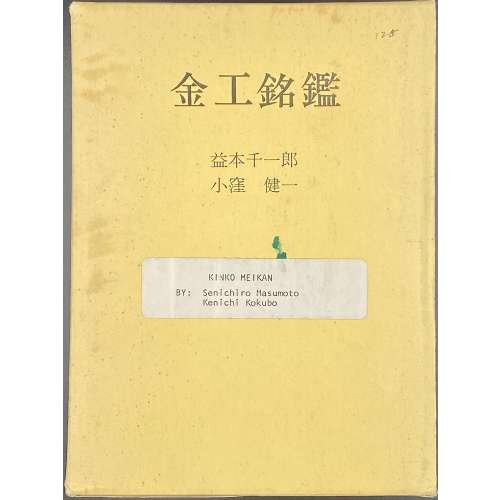 Publisher's brown cloth stamped in gilt, in a slipcase, 19 x 14 cm; pp.: [11] 1-657 [1] 1-12 [6]; in Japanese. With full English translation published in 1982 on letter-size writing paper in a separate folder, 29.5 x 23 cm, pp. [2] i-iii, 1-197, 1-52, 1-3. "Kinkō Meikan is a collection of photographs of signatures that appear on the tsuba and other fittings of the Japanese sword".
Publisher's brown cloth stamped in gilt, in a slipcase, 19 x 14 cm; pp.: [11] 1-657 [1] 1-12 [6]; in Japanese. With full English translation published in 1982 on letter-size writing paper in a separate folder, 29.5 x 23 cm, pp. [2] i-iii, 1-197, 1-52, 1-3. "Kinkō Meikan is a collection of photographs of signatures that appear on the tsuba and other fittings of the Japanese sword". -
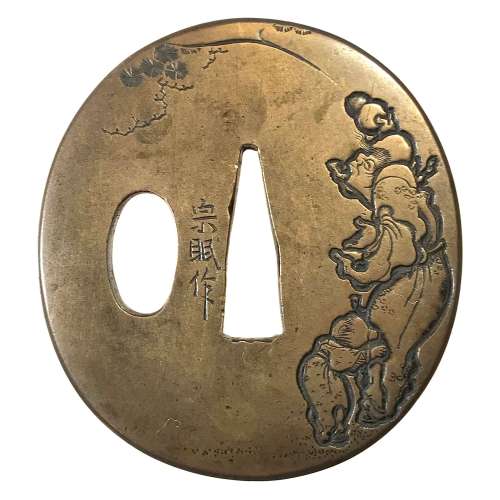
Sentoku tsuba of oval form with Sennin (Chinese immortal) motif carved in low relief (katakiribori). The Sennin is depicted with a double gourd in his right hand and a child beside his left hip. A pine tree carved on the reverse.
Signed: Sōmin saku (宗眠作) [M.Sesko]. Yokoya School (see The Japanese toso-kinko Schools by Markus Sesko, pp. 133-8).
Edo period (second half of the 18th century). Dimensions: Height: 61.6 mm; Width: 56.4 mm; Thickness: 4.2 mm; Weight: 85 g. -
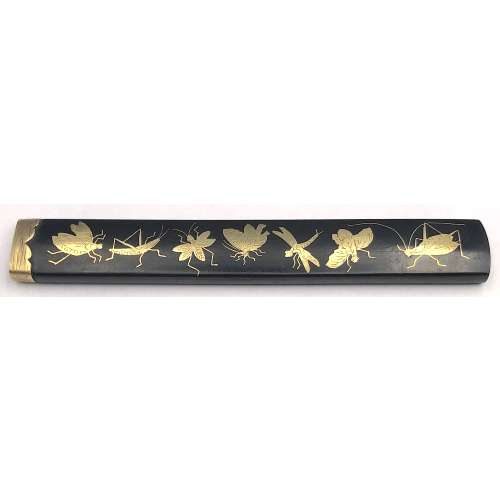 Kozuka with seven insects (fly, grasshopper, bee, butterfly, dragonfly, firefly, and cricket) and grass with dewdrops motif. Shakudō, flush gold inlay (hira-zōgan). 95.2 (H) x 13.7 mm (W). Mid Edo period (Late 17th - early 18th century, Genroku era 1688-1703). Unsigned. Kaga school. A look-a-like kozuka (with five insects) is illustrated at Japanese Sword Fittings. A descriptive catalogue of the Collection of G.H. Naunton, Esq., completed and illustrated by Henri L. Joly, - 1912 on plate XXIX, №691 [LIB-1389 in this Collection] with the following description at page 54: "Shakudō, inlaid with butterfly, dragon-fly, grasshopper, locust and another insect, gold."
Kozuka with seven insects (fly, grasshopper, bee, butterfly, dragonfly, firefly, and cricket) and grass with dewdrops motif. Shakudō, flush gold inlay (hira-zōgan). 95.2 (H) x 13.7 mm (W). Mid Edo period (Late 17th - early 18th century, Genroku era 1688-1703). Unsigned. Kaga school. A look-a-like kozuka (with five insects) is illustrated at Japanese Sword Fittings. A descriptive catalogue of the Collection of G.H. Naunton, Esq., completed and illustrated by Henri L. Joly, - 1912 on plate XXIX, №691 [LIB-1389 in this Collection] with the following description at page 54: "Shakudō, inlaid with butterfly, dragon-fly, grasshopper, locust and another insect, gold." See also tsuba TSU-0211 in this collection:
See also tsuba TSU-0211 in this collection:


-
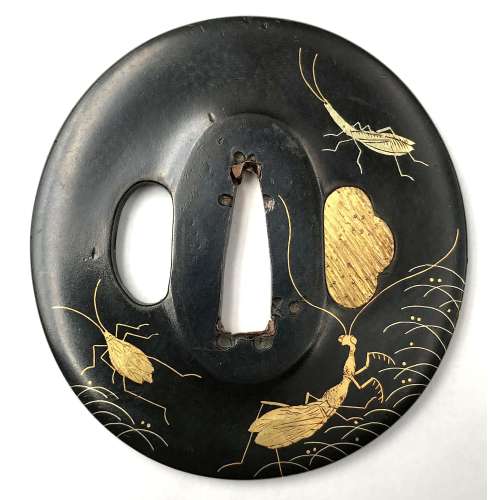 Shakudō tsuba of the slightly vertically elongated round form (nagamaru-gata) decorated by gold in flat inlay (hira-zōgan) with three insects (cricket, locust, and praying mantis), grass and dewdrops motif. Kogai hitsu-ana is plugged with gilded soft metal. Height: 70.2 mm; width: 66.4 mm x Thickness at seppa-dai: 4.5 mm. Edo period (from ca. 1700 to ca. 1850) Unsigned. Attributed to Kaga School or Murakami School. Almost identical tsuba (no dewdrops, though) is illustrated and described at page 60 of Kokusai Tosogu Kai. 7th International Convention & Exhibition, November 1st, 2011 at Tokyo National Museum, page 60. It is attributed to the Kaga School, Mid Edo period (Late 17th - early 18th century). Dimensions: 70.5 x 66 x 4.5 mm. "The rich black shakudo plate has been slightly lowered (dished out) and then polished. Gold insects crawl amongst grasses, depicted by Kaga style hirazogan (flat inlay). One tendril of the mantis overlaps onto seppa-dai. The mantis boldly looks out from the tsuba in a curious way. This style of Kaga tsuba was popular during the Genroku era (1688-1703)."Another source is Japanese Sword Fittings. A descriptive catalogue of the Collection of G.H. Naunton, Esq., completed and illustrated by Henri L. Joly, - 1912:
Shakudō tsuba of the slightly vertically elongated round form (nagamaru-gata) decorated by gold in flat inlay (hira-zōgan) with three insects (cricket, locust, and praying mantis), grass and dewdrops motif. Kogai hitsu-ana is plugged with gilded soft metal. Height: 70.2 mm; width: 66.4 mm x Thickness at seppa-dai: 4.5 mm. Edo period (from ca. 1700 to ca. 1850) Unsigned. Attributed to Kaga School or Murakami School. Almost identical tsuba (no dewdrops, though) is illustrated and described at page 60 of Kokusai Tosogu Kai. 7th International Convention & Exhibition, November 1st, 2011 at Tokyo National Museum, page 60. It is attributed to the Kaga School, Mid Edo period (Late 17th - early 18th century). Dimensions: 70.5 x 66 x 4.5 mm. "The rich black shakudo plate has been slightly lowered (dished out) and then polished. Gold insects crawl amongst grasses, depicted by Kaga style hirazogan (flat inlay). One tendril of the mantis overlaps onto seppa-dai. The mantis boldly looks out from the tsuba in a curious way. This style of Kaga tsuba was popular during the Genroku era (1688-1703)."Another source is Japanese Sword Fittings. A descriptive catalogue of the Collection of G.H. Naunton, Esq., completed and illustrated by Henri L. Joly, - 1912:
7-U17. Ron Hartmann Collection.
Kanazawa in Kaga was a centre of fine metal work during the whole of the Tokugawa period. At first the inlayers of Fushimi following the Daimyo Maeda went to Kanazawa, then some of the Gotō masters proceeded from Kyoto for short periods to work for the Daimyo, so that their influence was strongly impressed upon Kaga work..." A somewhat look-a-like tsuba is illustrated at plate XXVIII, Kaga Inlay, №653 with the following description at page 52: "Shakudō, inlaid with five insects in gold: crickets, praying mantis, grasshopper, in the style of Takagawara Ujitsugu.
According to M. Sesko, Ujitsugu was a master from Katsuki and Kaneko School in Kaga, son of Ujihira. Ujihira's father Ujiyoshi died in 1802. This brings us to the mid-19th century, instead of mid-18th or earlier. On the other hand, a very much look alike specimen at MFA collection (ACCESSION NUMBER 17.1061) has the with the following description: Edo period. Late 18th–early 19th century. Murakami School. Main material: shakudo; other metals: gold; decorative technique: iroe hirazogan.A detailed account of Murakami school can be found at The Japanese toso-kinko Schools.// Lulu Inc., 2012 by Markus Sesko, on pages 235-239. All-in-all, it's either Kaga School or Murakami School, either ca. 1700 or ca. 1850. Quite a range! SOLD
MFA # 17.1061
-
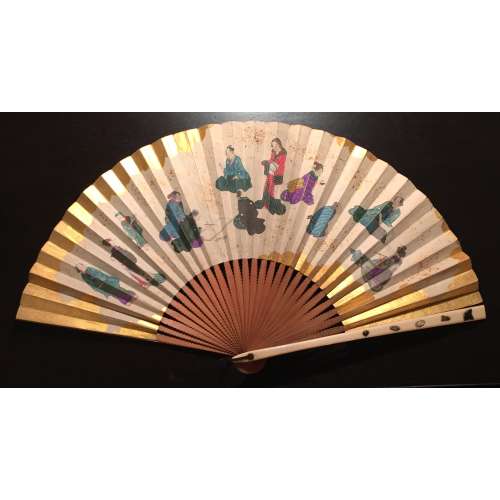 Late 19th-century (1850-1870) Japanese export fan. This fan has a double leaf painted with a different design on either side. Ivory encrusted with gemstones and other materials. Subject matter such as women wearing kimono is also more typical of export than domestic products (V&A). Autumn theme on the reverse.
Late 19th-century (1850-1870) Japanese export fan. This fan has a double leaf painted with a different design on either side. Ivory encrusted with gemstones and other materials. Subject matter such as women wearing kimono is also more typical of export than domestic products (V&A). Autumn theme on the reverse. -
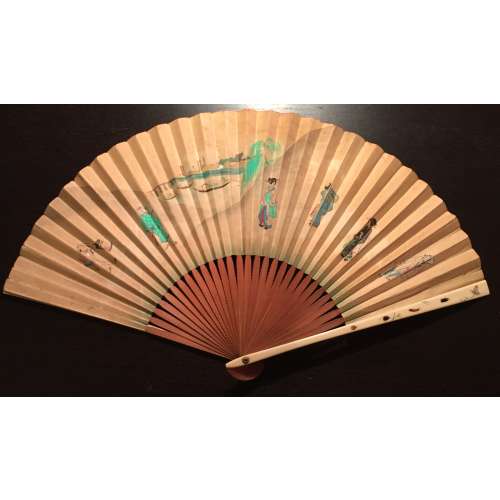 Late 19th-century (1850-1870) Japanese export fan. This fan has a double leaf painted with a different design on either side. Ivory encrusted with gemstones and other materials. Subject matter such as women wearing kimono is also more typical of export than domestic products (V&A). Summer (birds and flowers) theme on the reverse.
Late 19th-century (1850-1870) Japanese export fan. This fan has a double leaf painted with a different design on either side. Ivory encrusted with gemstones and other materials. Subject matter such as women wearing kimono is also more typical of export than domestic products (V&A). Summer (birds and flowers) theme on the reverse. -
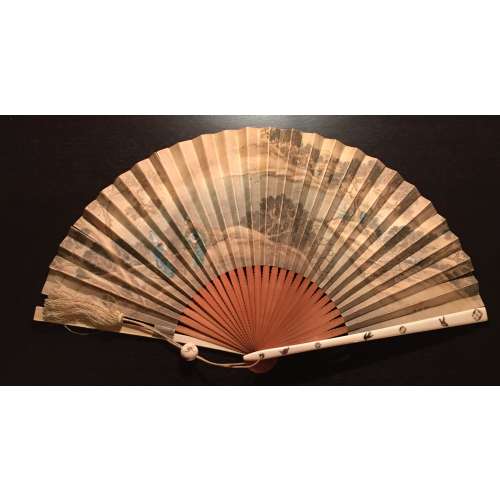 Late 19th-century (1850-1870) Japanese export fan. This fan has a double leaf painted with a different design on either side. Ivory encrusted with gemstones (birds and shippomon motif). Painting by ukiyo-e artist and printmaker Katsushika Isai (1821–1880) represents a riverside landscape with figures; birds and flowers on the reverse. Signed: Isai ga (為斎画) - "Painted by Isai".
Late 19th-century (1850-1870) Japanese export fan. This fan has a double leaf painted with a different design on either side. Ivory encrusted with gemstones (birds and shippomon motif). Painting by ukiyo-e artist and printmaker Katsushika Isai (1821–1880) represents a riverside landscape with figures; birds and flowers on the reverse. Signed: Isai ga (為斎画) - "Painted by Isai". -
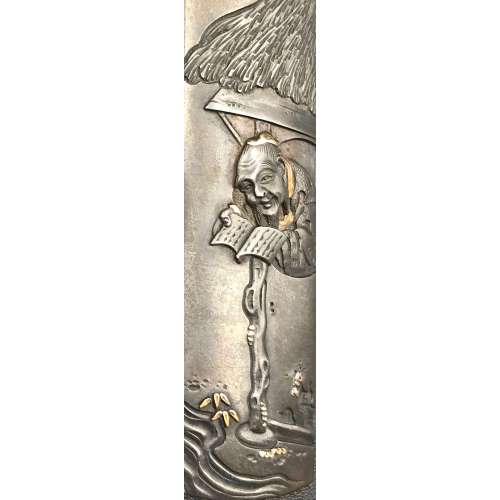 Shibuichi Kozuka carved in low relief (takabori, usuniku-bori) and inlaid in gold and silver with design of Shoko, reading by moonlight, thatch, pine rosettes, and fool moon. According to Henri L. Joly [LEGEND IN JAPANESE ART. London, 1908; LIB-1416 in this collection] Shoko was a Chinese student of Taoism who was so poor that he had no money to buy illuminating materials and read by moonlight. Shoko mentioned in the article about another Chinese character - Shaen, who was reading by the light emitted by glow-worms (see page 310). Signed on the back: Haruchika (春親) + kaō. Size: 97.3 mm (H) x 14.8 mm (W). Edo period, mid 19th century. NBTHK Certificate № 449542. Hamano Haruchika from Edo was a student of Haruyuki in 1848-54; Hamano School, Etchū Toyama Branch, according to M. Sesko's "Genealogy", page. 34. Most probably it is his work. Following the MFA data, it is also possible that "our" Haruchika is indeed Nara Haruchika or Tsuchiya Haruchika from Nara School; though I did not hind such artist in Markus Sesko books. However, in his "Toso-Kinko" on page 177 there is certain Shingorō who carried out his business under the name of Yanagawa Haruchika (1791-1857?)
Shibuichi Kozuka carved in low relief (takabori, usuniku-bori) and inlaid in gold and silver with design of Shoko, reading by moonlight, thatch, pine rosettes, and fool moon. According to Henri L. Joly [LEGEND IN JAPANESE ART. London, 1908; LIB-1416 in this collection] Shoko was a Chinese student of Taoism who was so poor that he had no money to buy illuminating materials and read by moonlight. Shoko mentioned in the article about another Chinese character - Shaen, who was reading by the light emitted by glow-worms (see page 310). Signed on the back: Haruchika (春親) + kaō. Size: 97.3 mm (H) x 14.8 mm (W). Edo period, mid 19th century. NBTHK Certificate № 449542. Hamano Haruchika from Edo was a student of Haruyuki in 1848-54; Hamano School, Etchū Toyama Branch, according to M. Sesko's "Genealogy", page. 34. Most probably it is his work. Following the MFA data, it is also possible that "our" Haruchika is indeed Nara Haruchika or Tsuchiya Haruchika from Nara School; though I did not hind such artist in Markus Sesko books. However, in his "Toso-Kinko" on page 177 there is certain Shingorō who carried out his business under the name of Yanagawa Haruchika (1791-1857?) -
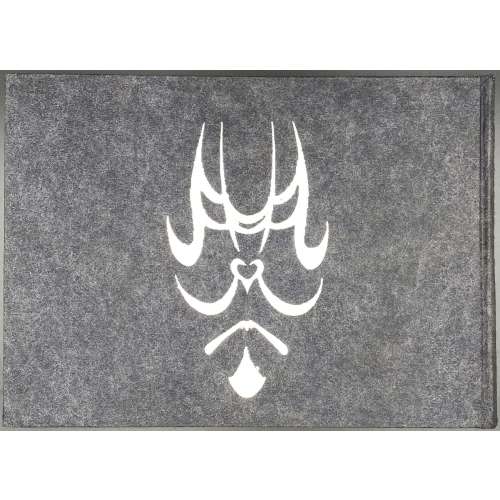 Book title: Kabuki fan-prints from Edo: Genroku to Enkyō periods (1688-1748) [江戸歌舞伎団扇絵] (Edo kabuki uchiwa-e: Genroku - Enkyō hen). Author: Shigeo Miyao [宮尾しげを] (Japanese, 1902 – 1982). Comments by: Sutezō Kimura [木村仙集] (Japanese, 20th century). Publisher: Inoue Shobō [井上書房] (Tokyo). Oblong volume bound in black washi paper with silver kabuki face design to front and silver lettering to spine and silver publisher’s name to back; three-colour title, folding frontispiece, second frontispiece, pp.: [6] foreword, contents, [2] f.t.p./blank, 3-134 [2], 43 full-page black & white illustrations, colophon slip pasted, bookstore label to back pastedown, in a pink slipcase with black lettering. Primitive fan prints from the Kaga collection, from 1691 to 1747. Edition: 1st edition, limited to 500 copies.
Book title: Kabuki fan-prints from Edo: Genroku to Enkyō periods (1688-1748) [江戸歌舞伎団扇絵] (Edo kabuki uchiwa-e: Genroku - Enkyō hen). Author: Shigeo Miyao [宮尾しげを] (Japanese, 1902 – 1982). Comments by: Sutezō Kimura [木村仙集] (Japanese, 20th century). Publisher: Inoue Shobō [井上書房] (Tokyo). Oblong volume bound in black washi paper with silver kabuki face design to front and silver lettering to spine and silver publisher’s name to back; three-colour title, folding frontispiece, second frontispiece, pp.: [6] foreword, contents, [2] f.t.p./blank, 3-134 [2], 43 full-page black & white illustrations, colophon slip pasted, bookstore label to back pastedown, in a pink slipcase with black lettering. Primitive fan prints from the Kaga collection, from 1691 to 1747. Edition: 1st edition, limited to 500 copies. -
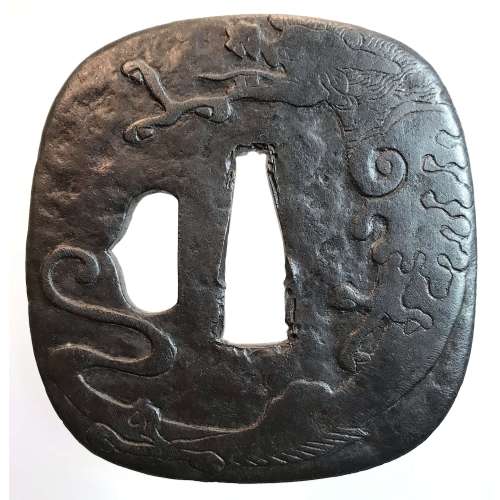 Shimizu-Jingo tsuba with a dragon and vajra (on reverse) motif. Unsigned. Possibly, 3rd or 4th master of Shimizu-Jingo family in Higo province. Iron. Low relief carving. Edo period, 1700's. Height: 75.4 mm, Width: 72.2 mm, Thickness at seppa-dai: 4.0 mm
Shimizu-Jingo tsuba with a dragon and vajra (on reverse) motif. Unsigned. Possibly, 3rd or 4th master of Shimizu-Jingo family in Higo province. Iron. Low relief carving. Edo period, 1700's. Height: 75.4 mm, Width: 72.2 mm, Thickness at seppa-dai: 4.0 mm -
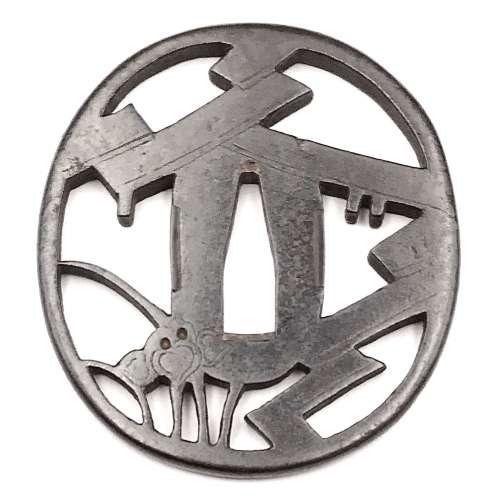 Iron tsuba of oval form with design of iris and plank bridge (yatsubashi) in openwork (sukashi). Rounded cornered rim. Unsigned. Attributed to Jingo - 3rd generation Shimizu, 2nd generation Jingo (1691-1777) [M. Sesko, Genealogy..., p. 94]. Edo period: Late 18th century (Hohreki / Meiwa era). Height: 69.5 mm. Width: 65.2 mm. Rim thickness: 4.6 mm. Center thickness: 4.8 mm. Provenance: Sasano Masayuki Collection, № 251: "Shimizu. Third generation Jingo (died at 87 years of age in the sixth year of An-ei, 1777). The eight-section bridge with irises are arranged to create the design of 'yatsubashi'. The features are unique for the Shimizu school and show no influence of the Hirita, Nishigaki or Hayashi schools". The design visually resembles a butterfly. As described in Family Crests of Japan by Stone Bridge Press [Family Crests of Japan; Stone Bridge Press, Berkeley, CA, 2007], and also in Japanese Family Crests by Yuzuru Okada [Yuzuru Okada. Japanese Family Crests // Series: Tourist Library: 37. Board of tourist industry; Japanese Government Railways, - 1941], there is a special technique used in construction of family crests, called 'reshaping' by the former and 'reconstruction' by the latter: "reconstruction is realized when a motive has its general shape composed of the detail of entirely different motive as, for instance, the crest of a butterfly formed of pine-needles. [...] The fanciful and ingenious forms evolved in this way may be represented by the kasiwa-giri or 'oak-leaf-paulownia', the ogi-bisi or 'fan-lozenge', the matuba-zuru or 'pine-needle-crane', the omodaka-kotyo or 'water-plantain-butterfly', etc." In our case we can call the motif yatsubashi-chocho or 'Iris-and-Bridge—Butterfly'.
Iron tsuba of oval form with design of iris and plank bridge (yatsubashi) in openwork (sukashi). Rounded cornered rim. Unsigned. Attributed to Jingo - 3rd generation Shimizu, 2nd generation Jingo (1691-1777) [M. Sesko, Genealogy..., p. 94]. Edo period: Late 18th century (Hohreki / Meiwa era). Height: 69.5 mm. Width: 65.2 mm. Rim thickness: 4.6 mm. Center thickness: 4.8 mm. Provenance: Sasano Masayuki Collection, № 251: "Shimizu. Third generation Jingo (died at 87 years of age in the sixth year of An-ei, 1777). The eight-section bridge with irises are arranged to create the design of 'yatsubashi'. The features are unique for the Shimizu school and show no influence of the Hirita, Nishigaki or Hayashi schools". The design visually resembles a butterfly. As described in Family Crests of Japan by Stone Bridge Press [Family Crests of Japan; Stone Bridge Press, Berkeley, CA, 2007], and also in Japanese Family Crests by Yuzuru Okada [Yuzuru Okada. Japanese Family Crests // Series: Tourist Library: 37. Board of tourist industry; Japanese Government Railways, - 1941], there is a special technique used in construction of family crests, called 'reshaping' by the former and 'reconstruction' by the latter: "reconstruction is realized when a motive has its general shape composed of the detail of entirely different motive as, for instance, the crest of a butterfly formed of pine-needles. [...] The fanciful and ingenious forms evolved in this way may be represented by the kasiwa-giri or 'oak-leaf-paulownia', the ogi-bisi or 'fan-lozenge', the matuba-zuru or 'pine-needle-crane', the omodaka-kotyo or 'water-plantain-butterfly', etc." In our case we can call the motif yatsubashi-chocho or 'Iris-and-Bridge—Butterfly'. -
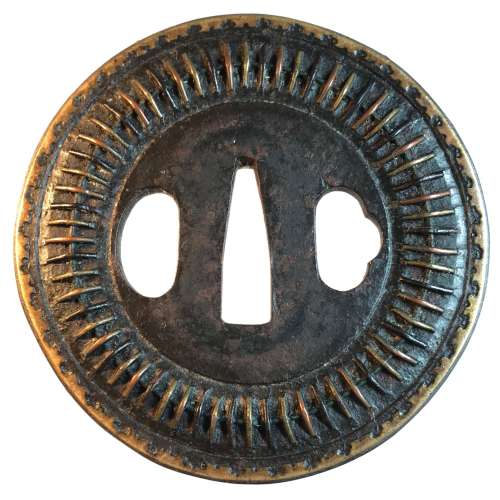 Iron tsuba of round form inlaid with brass, copper, and shakudō wire fastened to the surface with metal staples (mukade-zōgan); Scalloped brass inlay around the rim. Early Edo, 17th century. Height: 84.8 mm; Width 84.8 mm; Thickness at seppa-dai: 3.7 mm. Weight 161.6 g. Design is thought to resemble a centipede. "Centipede-like inlay (mukade zogan) of alternating iron and brass staples produce an appearance that was particularly favored by Takeda Shingen (1521-1573), one of the most powerful warlords of his time. The centipede is sacred to Bishamon (God of War) and especially propitious for a warrior. Shingen type, 16th century.” [The Peabody Museum collection of Japanese sword guards with selected pieces of sword furniture, by John D. Hamilton. Photographs by Mark Sexton. Salem, MA, 1975.] See also: http://varshavskycollection.com/shingen-tsuba/
Iron tsuba of round form inlaid with brass, copper, and shakudō wire fastened to the surface with metal staples (mukade-zōgan); Scalloped brass inlay around the rim. Early Edo, 17th century. Height: 84.8 mm; Width 84.8 mm; Thickness at seppa-dai: 3.7 mm. Weight 161.6 g. Design is thought to resemble a centipede. "Centipede-like inlay (mukade zogan) of alternating iron and brass staples produce an appearance that was particularly favored by Takeda Shingen (1521-1573), one of the most powerful warlords of his time. The centipede is sacred to Bishamon (God of War) and especially propitious for a warrior. Shingen type, 16th century.” [The Peabody Museum collection of Japanese sword guards with selected pieces of sword furniture, by John D. Hamilton. Photographs by Mark Sexton. Salem, MA, 1975.] See also: http://varshavskycollection.com/shingen-tsuba/ -
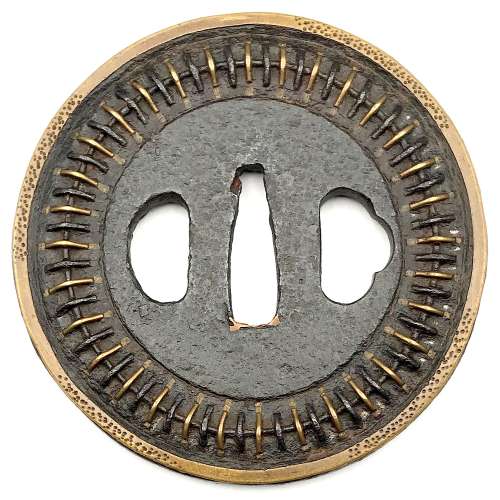 Iron tsuba of round form with circular iron wire fastened to the surface with iron and brass staples (mukade-zōgan); brass ring about 2.5 mm wide along the rim with chisel marks. Design repeats on the reverse. Copper sekigane. Early Edo, 17th century. Size: Height: 83.3 mm; width 83.9 mm; thickness at seppa-dai: 4.5 mm. Weight 173.6 g. Design is thought to resemble a centipede. "Centipede-like inlay (mukade zogan) of alternating iron and brass staples produce an appearance that was particularly favored by Takeda Shingen (1521-1573), one of the most powerful warlords of his time. The centipede is sacred to Bishamon (God of War) and especially propitious for a warrior. Shingen type, 16th century.” [The Peabody Museum collection of Japanese sword guards with selected pieces of sword furniture, by John D. Hamilton. Photographs by Mark Sexton. Salem, MA, 1975.] See also: http://varshavskycollection.com/shingen-tsuba/ SOLD
Iron tsuba of round form with circular iron wire fastened to the surface with iron and brass staples (mukade-zōgan); brass ring about 2.5 mm wide along the rim with chisel marks. Design repeats on the reverse. Copper sekigane. Early Edo, 17th century. Size: Height: 83.3 mm; width 83.9 mm; thickness at seppa-dai: 4.5 mm. Weight 173.6 g. Design is thought to resemble a centipede. "Centipede-like inlay (mukade zogan) of alternating iron and brass staples produce an appearance that was particularly favored by Takeda Shingen (1521-1573), one of the most powerful warlords of his time. The centipede is sacred to Bishamon (God of War) and especially propitious for a warrior. Shingen type, 16th century.” [The Peabody Museum collection of Japanese sword guards with selected pieces of sword furniture, by John D. Hamilton. Photographs by Mark Sexton. Salem, MA, 1975.] See also: http://varshavskycollection.com/shingen-tsuba/ SOLD -
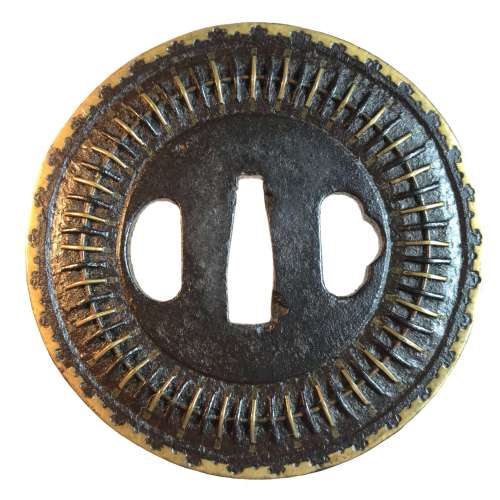 Mukade-zōgan tsuba with two types of wires. Iron, inlaid with brass and iron wire fastened to the surface with metal staples (mukade-zōgan); Brass inlay around the rim. Design is thought to resemble a centipede. "Centipede-like inlay (mukade zogan) of alternating iron and brass staples produce an appearance that was particularly favored by Takeda Shingen (1521-1573), one of the most powerful warlords of his time. The centipede is sacred to Bishamon (God of War) and especially propitious for a warrior. Shingen type, 16th century.” [The Peabody Museum collection of Japanese sword guards with selected pieces of sword furniture, by John D. Hamilton. Photographs by Mark Sexton. Salem, MA, 1975.] Height: 85.8 mm; Width 86.2 mm; Thickness at seppa-dai: 4.3 mm. Weight 177.6 g. Early Edo, 17th century. http://varshavskycollection.com/shingen-tsuba/
Mukade-zōgan tsuba with two types of wires. Iron, inlaid with brass and iron wire fastened to the surface with metal staples (mukade-zōgan); Brass inlay around the rim. Design is thought to resemble a centipede. "Centipede-like inlay (mukade zogan) of alternating iron and brass staples produce an appearance that was particularly favored by Takeda Shingen (1521-1573), one of the most powerful warlords of his time. The centipede is sacred to Bishamon (God of War) and especially propitious for a warrior. Shingen type, 16th century.” [The Peabody Museum collection of Japanese sword guards with selected pieces of sword furniture, by John D. Hamilton. Photographs by Mark Sexton. Salem, MA, 1975.] Height: 85.8 mm; Width 86.2 mm; Thickness at seppa-dai: 4.3 mm. Weight 177.6 g. Early Edo, 17th century. http://varshavskycollection.com/shingen-tsuba/ -
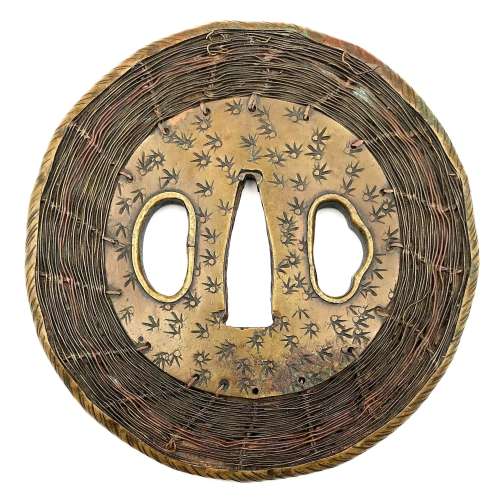 Shingen school (or style) tsuba of round form with iron core and web, covered with a thin brass plate decorated with star-shaped punch marks. The rim of tsuba is a brass nawame-fukurin. Between the central brass plate and the rim there is woven wire of brass and copper in a basketweave pattern. Both hitsu-ana have raised rim. Traces of oxidation. Unsigned. Edo period, 18th century. Size: Height: 88.4 mm, Width: 86.6 mm, Thickness at seppa-dai: 4.6 mm. Weight: 132.4 g. Robert E. Haynes in his "Study Collection of Japanese Sword Fittings. Nihon Art Publishers, 2010" on p. 117 says: "Brass outer plate of round shape. This tsuba has an iron core tsuba of spoke form as made by Saotome school, ca. 1500. There are brass plates on either side connected to the rim by woven brass and shakudō wire. The wire has been hand drawn, which is very difficult. The hitsuana are brass lined and the rim has a brass cover. This type of tsuba is referred to as a Shingen tsuba. This is a reference to Takeda Shingen Harunobu (1521-1573), the great and famous daimyō." For reference see the MFA collection. A look-a-like tsuba is illustrated in Compton Collection, vol. 2, p. 26-27, №52:More details and examples can be found at: http://varshavskycollection.com/shingen-tsuba/
Shingen school (or style) tsuba of round form with iron core and web, covered with a thin brass plate decorated with star-shaped punch marks. The rim of tsuba is a brass nawame-fukurin. Between the central brass plate and the rim there is woven wire of brass and copper in a basketweave pattern. Both hitsu-ana have raised rim. Traces of oxidation. Unsigned. Edo period, 18th century. Size: Height: 88.4 mm, Width: 86.6 mm, Thickness at seppa-dai: 4.6 mm. Weight: 132.4 g. Robert E. Haynes in his "Study Collection of Japanese Sword Fittings. Nihon Art Publishers, 2010" on p. 117 says: "Brass outer plate of round shape. This tsuba has an iron core tsuba of spoke form as made by Saotome school, ca. 1500. There are brass plates on either side connected to the rim by woven brass and shakudō wire. The wire has been hand drawn, which is very difficult. The hitsuana are brass lined and the rim has a brass cover. This type of tsuba is referred to as a Shingen tsuba. This is a reference to Takeda Shingen Harunobu (1521-1573), the great and famous daimyō." For reference see the MFA collection. A look-a-like tsuba is illustrated in Compton Collection, vol. 2, p. 26-27, №52:More details and examples can be found at: http://varshavskycollection.com/shingen-tsuba/
Compton Collection, vol. 2, p. 26-27, №52.
-
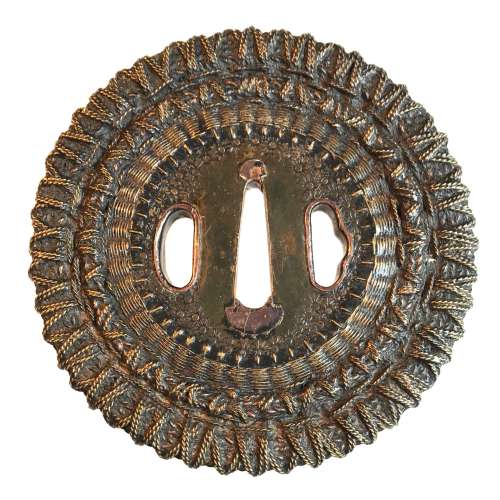 Shingen school (or style) tsuba of round form with an iron core of spoked-wheel shape, with its centre covered with a copper plate decorated with star-shaped punch marks. From this copper plate outward, the body is formed by brass and copper wire (flat and twisted) in a weave pattern. Both hitsu-ana are outlined in brass with a raised rim. Copper sekigane. Unsigned. Edo period, 18th century. SOLD Height: 98.0 mm, Width: 97.4 mm, Thickness at seppa-dai: 6.0 mm. Weight: 290 g. NBTHK certificate №436696: 'Hozon' attestation. Citing "JAPANESE SWORD-MOUNTS IN THE COLLECTIONS OF FIELD MUSEUM" by Helen C. Gunsaulus, Assistant Curator of Japanese Ethnology. 61 plates. Berthold Laufer, Curator of Anthropology. Field Museum of Natural History, Publication 216, Anthropological Series, Volume XVI; Chicago, 1923; p.45: "An unusual group of tsuba popular in the late sixteenth century and afterwards is made up of those guards known as Shingen tsuba, a name which was derived from a sixteenth-century warrior, Takeda Shingen (Takeda Harunobu, 1521-73), who is said to have preferred this style of guard, as it combined strength and lightness. Under the category of "Shingen", four different types abd generally listed, though a fifth appears in the drawings in the Boston Catalogue of Okabe Kakuya "Japanese Sword Guards" (p. 21). It is square, that form which is said to have been used in Ashikaga days for scaling walls, the sword having been set up as a step. [...] The following descriptions include, however, the Shingen tsuba usually met with.
Shingen school (or style) tsuba of round form with an iron core of spoked-wheel shape, with its centre covered with a copper plate decorated with star-shaped punch marks. From this copper plate outward, the body is formed by brass and copper wire (flat and twisted) in a weave pattern. Both hitsu-ana are outlined in brass with a raised rim. Copper sekigane. Unsigned. Edo period, 18th century. SOLD Height: 98.0 mm, Width: 97.4 mm, Thickness at seppa-dai: 6.0 mm. Weight: 290 g. NBTHK certificate №436696: 'Hozon' attestation. Citing "JAPANESE SWORD-MOUNTS IN THE COLLECTIONS OF FIELD MUSEUM" by Helen C. Gunsaulus, Assistant Curator of Japanese Ethnology. 61 plates. Berthold Laufer, Curator of Anthropology. Field Museum of Natural History, Publication 216, Anthropological Series, Volume XVI; Chicago, 1923; p.45: "An unusual group of tsuba popular in the late sixteenth century and afterwards is made up of those guards known as Shingen tsuba, a name which was derived from a sixteenth-century warrior, Takeda Shingen (Takeda Harunobu, 1521-73), who is said to have preferred this style of guard, as it combined strength and lightness. Under the category of "Shingen", four different types abd generally listed, though a fifth appears in the drawings in the Boston Catalogue of Okabe Kakuya "Japanese Sword Guards" (p. 21). It is square, that form which is said to have been used in Ashikaga days for scaling walls, the sword having been set up as a step. [...] The following descriptions include, however, the Shingen tsuba usually met with.- So-called Mukade ("centipede") tsuba are made of iron in which a centepede is inlaid in brass or copper wire. Mukade tsuba of Myōchin and Umetada warkmanship have been found with the inscription, "Made to the taste of Takeda Shingen".
- There are those of solid iron, with need centers of brass, to the edges of which is affixed a weaving of brass and copper wires which is bound to the foundation disk by a rim, usually decorated simply.
- Another type is of solid iron, bored at intervals and laced with braided or twisted wires of copper and brass.
- The fourth type is a chrysanthemoid form, chiselled in open work and laced or woven tightly with copper and brass wire."

Compton Collection, Part II, p.p. 26-27, №54.
-
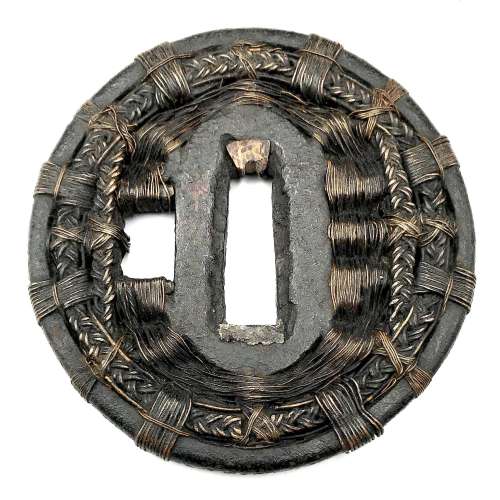 Shingen school tsuba with woven wire pattern. Iron core, woven brass wire. Height: 72.5 mm; Width 69.8 mm; Thickness at seppa-dai: 4.0 mm. Weight 88.8 g. Late Muromachi, 16th century. SOLD http://varshavskycollection.com/shingen-tsuba/
Shingen school tsuba with woven wire pattern. Iron core, woven brass wire. Height: 72.5 mm; Width 69.8 mm; Thickness at seppa-dai: 4.0 mm. Weight 88.8 g. Late Muromachi, 16th century. SOLD http://varshavskycollection.com/shingen-tsuba/ -
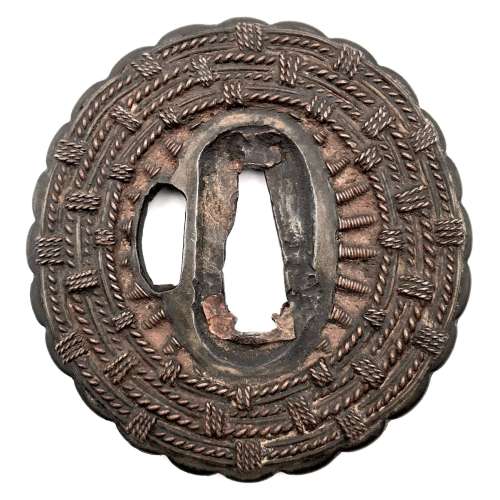 Tsuba of chrysanthemoid form (kikka-gata) with yamagane core and woven copper wire pattern. Copper sekigane. Shingen school. Height: 70.2 mm; Width 67.2 mm; Thickness at seppa-dai: 3.4-3.6 mm, overall 7.3 mm. Weight 82.7 g Inscription on the wooden box reads: "Muromachi period Mumei Zōgan Shingen Tsuba" Muromachi period, 16th century. Age attribution is based on the fact that the core is made of yamagane; later copies of Edo period are usually made of iron. This small and light tsuba was likely mounted on a combat sword, while larger and much heavier woven wire Shingen tsuba of Edo period were of purely decorative purpose. http://varshavskycollection.com/shingen-tsuba/
Tsuba of chrysanthemoid form (kikka-gata) with yamagane core and woven copper wire pattern. Copper sekigane. Shingen school. Height: 70.2 mm; Width 67.2 mm; Thickness at seppa-dai: 3.4-3.6 mm, overall 7.3 mm. Weight 82.7 g Inscription on the wooden box reads: "Muromachi period Mumei Zōgan Shingen Tsuba" Muromachi period, 16th century. Age attribution is based on the fact that the core is made of yamagane; later copies of Edo period are usually made of iron. This small and light tsuba was likely mounted on a combat sword, while larger and much heavier woven wire Shingen tsuba of Edo period were of purely decorative purpose. http://varshavskycollection.com/shingen-tsuba/ -
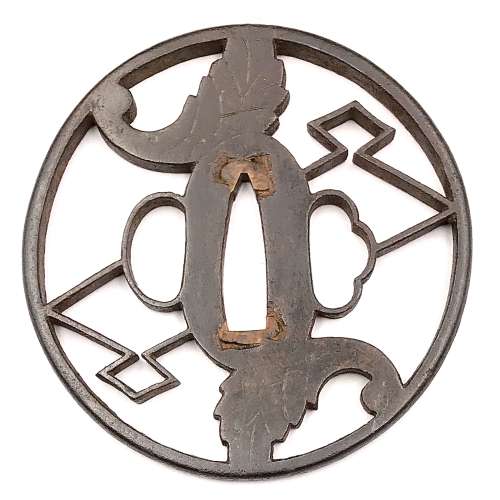 Iron tsuba of round form with design of ginger and double diamonds (myoga-ni-nigaibishi) in openwork (sukashi), details carved in kebori technique. Slightly rounded square rim. Copper sekigane. Shoami school. Early Edo period: Late 17th century (Kanbun/Enppo era). Height: 80.1 mm. Width: 79.8 mm. Rim thickness: 5.0 mm. Center thickness: 4.7 mm. Provenance: Sasano Masayuki Collection, № 110.
Iron tsuba of round form with design of ginger and double diamonds (myoga-ni-nigaibishi) in openwork (sukashi), details carved in kebori technique. Slightly rounded square rim. Copper sekigane. Shoami school. Early Edo period: Late 17th century (Kanbun/Enppo era). Height: 80.1 mm. Width: 79.8 mm. Rim thickness: 5.0 mm. Center thickness: 4.7 mm. Provenance: Sasano Masayuki Collection, № 110. -
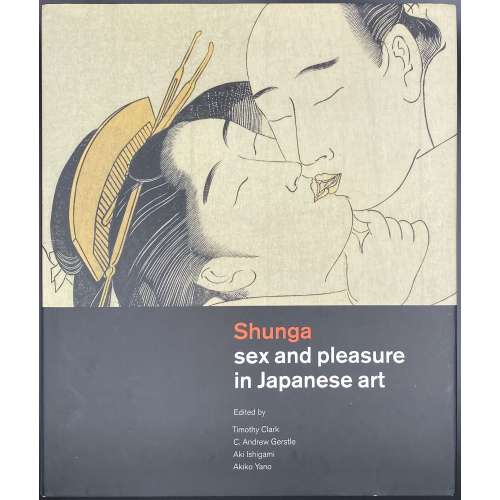 Hardcover volume, 29.6 x 25 x 4 cm, in red cloth with black lettering to spine, in pictorial dust jacket, profusely illustrated in colour; pp.: [1-6] 7-536, total 268 leaves and 2 folding plates extraneous to collation. Title-page: {Hotei's device} Hotei Publishing | Shunga | sex and pleasure in Japanese art | Edited by | Timothy Clark | C. Andrew Gerstle | Aki Ishigami | Akiki Yano || Contents: The Cultural Historical Significance and Importance of Japanese Shunga / Kobayashi Tadashi. Introduction: What Was Shunga? / C. Andrew Gerstle; Who Were the Audiences for Shunga? / Hayakawa Monta. (1) Early Shunga before 1765: Shunga Paintings before the `Floating World' / Akiko Yano; Chinese Chunhua and Japanese Shunga / Ishigami Aki; Shunga and the Rise of Print Culture / Asano Shugo. (2) Masterpieces of Shunga 1765-1850: The Essence of Ukiyo-e Shunga / Kobayashi Tadashi; Erotic Books as Luxury Goods / Ellis Tinios; Listening to the Voices in Shunga / Hayakawa Monta; The Tale of Genji in Shunga / Sato Satoru. (3) Censorship: Timeline of Censorship; Shunga and Censorship in the Edo Period (1600-1868) / Jennifer Preston; Graph of approximate output of shunga print series and books; The Censorship of Shunga in the Modern Era / Ishigami Aki; Shunga Studies in the Showa Era (1926-89) / Shirakura Yoshihiko. (4) Contexts for Shunga: Traditional Uses of Shunga / Yamamoto Yukari; The Distribution and Circulation of Erotic Prints and Books in the Edo Period Laura Moretti; Shunga and Parody / C. Andrew Gerstle; Popular Cults of Sex Organs in Japan / Suzuki Kenko; Grotesque Shunga / Ishigami Aki; Violence in Shunga / Higuchi Kazutaka; Foreign Connections in Shunga / Timon Screech; Children in Shunga / Akiko Yano; Shunga and the Floating World / Matsuba Ryoko. (5) Shunga in the Meiji Era: Erotic Art of the Meiji Era (1868-1912) / Rosina Buckland; The Modern West's Discovery of Shunga / Ricard Bru. Published to accompany the exhibition Shunga: sex and pleasure in Japanese art at the British Museum from 3 October 2013 to 5 January 2014. Abstract: This catalogue aims to answer some key questions about what is shunga and why it was produced. In particular, the social and cultural contexts for sex art in Japan are explored. Erotic Japanese art was heavily suppressed in Japan from the 1870s onwards as part of a process of cultural 'modernisation' that imported many contemporary western moral values. Only in the last twenty years or so has it been possible to publish unexpurgated examples in Japan and this landmark book places erotic Japanese art in its historical and cultural context for the first time. This book looks at painted and printed erotic images produced in Japan during the Edo period (1600-1868) and early Meiji era (1868-1912). These are related to the wider contexts of literature, theatre, the culture of the pleasure quarters, and urban consumerism; and interpreted in terms of their sensuality, reverence, humour and parody. Contributors: Timothy Clark (British, b. 1959) Timothy Clark (British, b. 1959) C. Andrew Gerstle (American, 1951) Aki Ishigami [石上阿希] (Japanese) Akiki Yano
Hardcover volume, 29.6 x 25 x 4 cm, in red cloth with black lettering to spine, in pictorial dust jacket, profusely illustrated in colour; pp.: [1-6] 7-536, total 268 leaves and 2 folding plates extraneous to collation. Title-page: {Hotei's device} Hotei Publishing | Shunga | sex and pleasure in Japanese art | Edited by | Timothy Clark | C. Andrew Gerstle | Aki Ishigami | Akiki Yano || Contents: The Cultural Historical Significance and Importance of Japanese Shunga / Kobayashi Tadashi. Introduction: What Was Shunga? / C. Andrew Gerstle; Who Were the Audiences for Shunga? / Hayakawa Monta. (1) Early Shunga before 1765: Shunga Paintings before the `Floating World' / Akiko Yano; Chinese Chunhua and Japanese Shunga / Ishigami Aki; Shunga and the Rise of Print Culture / Asano Shugo. (2) Masterpieces of Shunga 1765-1850: The Essence of Ukiyo-e Shunga / Kobayashi Tadashi; Erotic Books as Luxury Goods / Ellis Tinios; Listening to the Voices in Shunga / Hayakawa Monta; The Tale of Genji in Shunga / Sato Satoru. (3) Censorship: Timeline of Censorship; Shunga and Censorship in the Edo Period (1600-1868) / Jennifer Preston; Graph of approximate output of shunga print series and books; The Censorship of Shunga in the Modern Era / Ishigami Aki; Shunga Studies in the Showa Era (1926-89) / Shirakura Yoshihiko. (4) Contexts for Shunga: Traditional Uses of Shunga / Yamamoto Yukari; The Distribution and Circulation of Erotic Prints and Books in the Edo Period Laura Moretti; Shunga and Parody / C. Andrew Gerstle; Popular Cults of Sex Organs in Japan / Suzuki Kenko; Grotesque Shunga / Ishigami Aki; Violence in Shunga / Higuchi Kazutaka; Foreign Connections in Shunga / Timon Screech; Children in Shunga / Akiko Yano; Shunga and the Floating World / Matsuba Ryoko. (5) Shunga in the Meiji Era: Erotic Art of the Meiji Era (1868-1912) / Rosina Buckland; The Modern West's Discovery of Shunga / Ricard Bru. Published to accompany the exhibition Shunga: sex and pleasure in Japanese art at the British Museum from 3 October 2013 to 5 January 2014. Abstract: This catalogue aims to answer some key questions about what is shunga and why it was produced. In particular, the social and cultural contexts for sex art in Japan are explored. Erotic Japanese art was heavily suppressed in Japan from the 1870s onwards as part of a process of cultural 'modernisation' that imported many contemporary western moral values. Only in the last twenty years or so has it been possible to publish unexpurgated examples in Japan and this landmark book places erotic Japanese art in its historical and cultural context for the first time. This book looks at painted and printed erotic images produced in Japan during the Edo period (1600-1868) and early Meiji era (1868-1912). These are related to the wider contexts of literature, theatre, the culture of the pleasure quarters, and urban consumerism; and interpreted in terms of their sensuality, reverence, humour and parody. Contributors: Timothy Clark (British, b. 1959) Timothy Clark (British, b. 1959) C. Andrew Gerstle (American, 1951) Aki Ishigami [石上阿希] (Japanese) Akiki Yano -
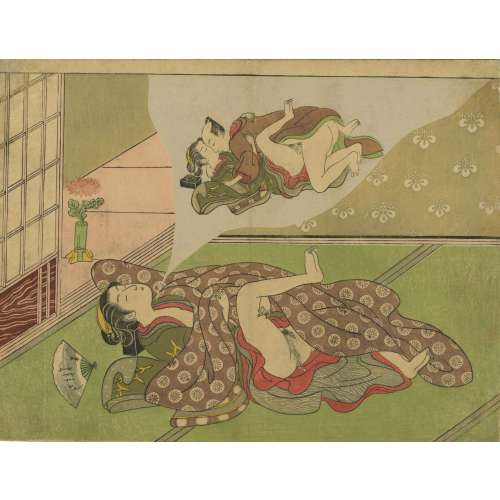 Attributed to Suzuki Harunobu (Japanese: 鈴木 春信; c. 1725 – 7 July 1770). Sunga. Woman dreaming of making love. British museum attributes to Ippitsusai Buncho (一筆斉文調).
Attributed to Suzuki Harunobu (Japanese: 鈴木 春信; c. 1725 – 7 July 1770). Sunga. Woman dreaming of making love. British museum attributes to Ippitsusai Buncho (一筆斉文調). -
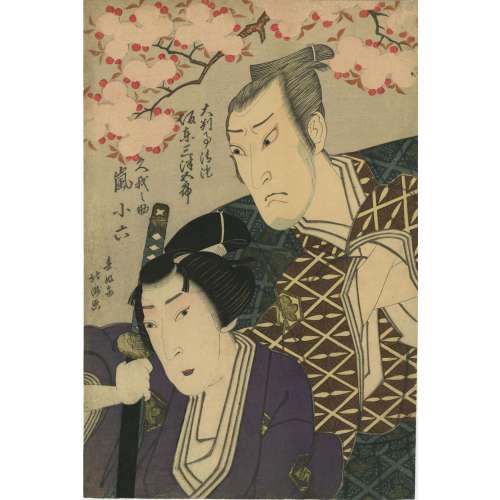 Bandō Mitsugorō III as Daihanji Kiyozumi and Arashi Koroku IV as Koganosuke in kabuki play Imoseyama, an example of womanly virtue (Imoseyama onna teikin). 大判事清澄 坂東三津五郎」(三代)・「久我之助 嵐小六」(四代) Artist: Shunkōsai Hokushū [春好斎北洲] (Japanese, fl. 1802 – 1832) Year: 1821 (3rd month). MFA description: “The Kabuki play Mount Imo and Mount Se: An Exemplary Tale of Womanly Virtue (Imoseyama onna teikin), originally based on a puppet play, is set in ancient Japan when the Soga clan served as regents to the emperor. Two children, Hinadori and Koganosuke, of rival court families, are held hostage under orders from the tyrant Soga no Iruka to ensure their families do not revolt. The children fall in love, but rather than create conflicts for their families they each vow to die by suicide. When the parents learn of their plans, they resolve to cooperate to overthrow Iruka. Here Koganosuke and his father Kiyozumi are shown; a companion sheet on the left would have shown Hinadori and her mother Sadaka.” The play Imoseyama, an example of womanly virtue (Imoseyama onna teikin), was staged at Osaka's Kado Shibai (Kadoza, Kado Gekijô, Kado no Shibai) from 3/1821. According to Herwig, it is the right sheet of a diptych (see below). MFA Accession number: 2011.128 Kabuki actors: Bandō Mitsugorō III [三代目 坂東 三津五郎] (Japanese, 1775 – 1831); other names: Bandō Minosuke I, Morita Kanjirô II, Bandō Mitahachi I, Bandō Minosuke I, Bandō Mitahachi I. Arashi Koroku IV [四代目嵐小六] (Japanese, 1783 – 1826)
Bandō Mitsugorō III as Daihanji Kiyozumi and Arashi Koroku IV as Koganosuke in kabuki play Imoseyama, an example of womanly virtue (Imoseyama onna teikin). 大判事清澄 坂東三津五郎」(三代)・「久我之助 嵐小六」(四代) Artist: Shunkōsai Hokushū [春好斎北洲] (Japanese, fl. 1802 – 1832) Year: 1821 (3rd month). MFA description: “The Kabuki play Mount Imo and Mount Se: An Exemplary Tale of Womanly Virtue (Imoseyama onna teikin), originally based on a puppet play, is set in ancient Japan when the Soga clan served as regents to the emperor. Two children, Hinadori and Koganosuke, of rival court families, are held hostage under orders from the tyrant Soga no Iruka to ensure their families do not revolt. The children fall in love, but rather than create conflicts for their families they each vow to die by suicide. When the parents learn of their plans, they resolve to cooperate to overthrow Iruka. Here Koganosuke and his father Kiyozumi are shown; a companion sheet on the left would have shown Hinadori and her mother Sadaka.” The play Imoseyama, an example of womanly virtue (Imoseyama onna teikin), was staged at Osaka's Kado Shibai (Kadoza, Kado Gekijô, Kado no Shibai) from 3/1821. According to Herwig, it is the right sheet of a diptych (see below). MFA Accession number: 2011.128 Kabuki actors: Bandō Mitsugorō III [三代目 坂東 三津五郎] (Japanese, 1775 – 1831); other names: Bandō Minosuke I, Morita Kanjirô II, Bandō Mitahachi I, Bandō Minosuke I, Bandō Mitahachi I. Arashi Koroku IV [四代目嵐小六] (Japanese, 1783 – 1826)
Ref.: [LIB-1197.2016] Arendie and Henk Herwig. Heroes of the kabuki stage: an introduction to kabuki with retellings of famous plays, illustrated by woodblock prints. — Amsterdam: Hotei Publishing, 2004; p. 72:
Ref: [LIB-2973.2022] Ukiyo-e: A journey through the Floating World / Exhibition catalogue (Japan, Jan-Jul 2014). — The Yomiuri Shimbun, 2014; № 358, p. 226. "Bandō Mitsugorō III as Grand arbiter Kiyosumi and Arashi Koroku IV as Koganosuke":
-
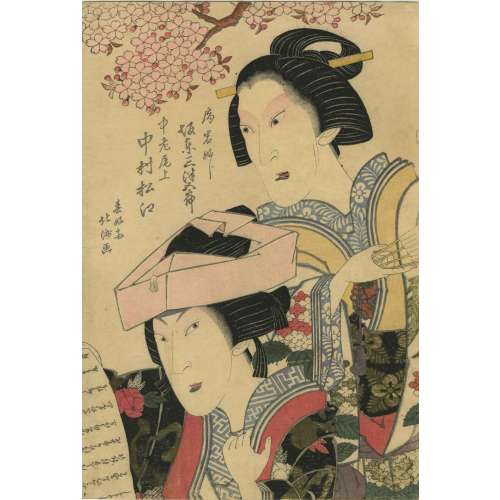 Bando Mitsugorō III as Lady Iwafuji and Nakamura Matsue III as Lady Onoe, 1821.「局岩ふじ 坂東三津五郎」(三代)、「中老尾上 中村松江」(三代) in kabuki play Kagamiyama Kokyô no Nishikie [鏡山旧錦繪] (Mirror mountain: A women’s treasury of loyalty); author: Yô Yôdai. Artist: Shunkōsai Hokushū (春好斎 北洲), who is also known as Shunkō IV, active from about 1802 to 1832. Actors: Bandō Mitsugorō III [三代目 坂東 三津五郎] (Japanese, 1775 – 1831); other names: Bandō Minosuke I, Morita Kanjirô II, Bandō Mitahachi I, Bandō Minosuke I, Bandō Mitahachi I. Nakamura Matsue III [三代目中村松江] (Japanese, 1786-1855); other names: Nakamura Sankō I, Nakamura Tomijūrō II, Ichikawa Kumatarō. Year: 1821 (Bunsei 4), 1st month. Publisher: Wataya Kihei (Wataki) (Japanese, fl. c. 1809 – 1885) Signed Shunkôsai Hokushû ga 春好斎北洲画. MFA Accession № 11.35375. MFA description: "Play: Keisei Kagamiyama (Mirror Mountain, a Courtesan Play). Theatre: Kado けいせい双鏡山(けいせいかがみやま)角. Ref.: [LIB-1193.2013] Leiter. Kabuki Encyclopedia, p. 156; [LIB-0879-2.2015] Kabuki plays on stage (vol. 2): 1773-1799, pp. 172-212.
Bando Mitsugorō III as Lady Iwafuji and Nakamura Matsue III as Lady Onoe, 1821.「局岩ふじ 坂東三津五郎」(三代)、「中老尾上 中村松江」(三代) in kabuki play Kagamiyama Kokyô no Nishikie [鏡山旧錦繪] (Mirror mountain: A women’s treasury of loyalty); author: Yô Yôdai. Artist: Shunkōsai Hokushū (春好斎 北洲), who is also known as Shunkō IV, active from about 1802 to 1832. Actors: Bandō Mitsugorō III [三代目 坂東 三津五郎] (Japanese, 1775 – 1831); other names: Bandō Minosuke I, Morita Kanjirô II, Bandō Mitahachi I, Bandō Minosuke I, Bandō Mitahachi I. Nakamura Matsue III [三代目中村松江] (Japanese, 1786-1855); other names: Nakamura Sankō I, Nakamura Tomijūrō II, Ichikawa Kumatarō. Year: 1821 (Bunsei 4), 1st month. Publisher: Wataya Kihei (Wataki) (Japanese, fl. c. 1809 – 1885) Signed Shunkôsai Hokushû ga 春好斎北洲画. MFA Accession № 11.35375. MFA description: "Play: Keisei Kagamiyama (Mirror Mountain, a Courtesan Play). Theatre: Kado けいせい双鏡山(けいせいかがみやま)角. Ref.: [LIB-1193.2013] Leiter. Kabuki Encyclopedia, p. 156; [LIB-0879-2.2015] Kabuki plays on stage (vol. 2): 1773-1799, pp. 172-212.


